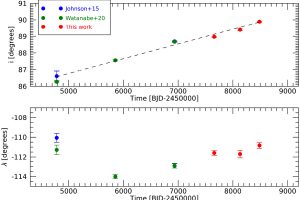The hot Jupiter WASP-33b targeted by HARPS-N. The study: “The GAPS Programme at TNG. XXXI. The WASP-33 system revisited with HARPS-N” of F. Borsa (INAF – AO of Brera) recently appeared on A&A

Hot Jupiters are gaseous giant planets that orbit very close to their stars (within a typical distance of less than 0.1 Astronomical Units, AU, where 1 AU is the average distance between Earth and Sun, about 150 million of km). These planets are of great interest for astronomers both because of the effects due to the intense incident stellar radiation, mainly in the UV band, and because of the effects of the star-planet interactions. For instance, the temperature of the daily side of the hot Jupiters can be in excess of 2000 K, with important phenomena of gas transport and chemical mixing between the two sides. Besides, the close distance between star and planet can trigger intense tidal interactions which may affect the rotation of the system, the magnetic activity of the star, the oblateness of the planet, and induce stellar pulsations.
The planet WASP-33b (with a mass of 2.2 Jupiter masses and a radius of 1.6 Jupiter radii) is one of the most interesting hot Jupiters known. The planet orbits around a δ-Scuti star of A spectral class (with an effective temperature of about 7500 K), and it has a spin-orbit inclination (which is the angle between the rotation axis of the planet and its orbital plane) of -110 degrees. Several authors have found evidence of a nodal precession of its orbit. WASP-33b is also a good candidate for studies of the star-planet interactions, which may trigger in this case some pulsation modes observed in WASP-33.
Such an interesting planet was indeed included among the targets of the project GAPS (Global Architecture of Planetary System), a survey performed with the spectrograph HARPS-N mounted on the Telescopio Nazionale Galileo, which is aimed at characterizing known exoplanetary systems. The team of researchers led by the astronomer F. Borsa (INAF – Astronomical Observatory of Brera), analyzed a series of HARPS-N observations of WASP-33 acquired during the transits of the planet (e.g.: when the planet is moving in front of its star along our line of sigh). The researchers have confirmed the nodal precession of the orbit of WASP-33b, measuring a precession period of about 1100 years. The observations also allowed astronomers to detect signatures of the presence of hydrogen (Hα and Hβ lines) in the planet upper atmosphere. The ratio of the intensity of the two hydrogen lines is also variable, suggesting that it may be affected by the magnetic activity of the star. The authors have also found evidence supporting the existence of pulsation modes in WASP-33 which are triggered by the interaction with the planet. The study is described in the paper: “The GAPS Programme at TNG. XXXI. The WASP-33 system revisited with HARPS-N“, recently appeared on Astronomy & Astrophysics. Among the coauthors, also the astronomers S. Benatti, J. Maldonado, A. Maggio e G. Micela of INAF – Astronomical Observatory of Palermo.
the figure (click here to visualize the entire image) shows how the spin-orbit angle and the inclination of the orbit of WASP-33b change with time.
Mario Giuseppe Guarcello ( follow mguarce) ( youtube)
Subscribe the Youtube channel of the Astronomical Observatory of Palermo
